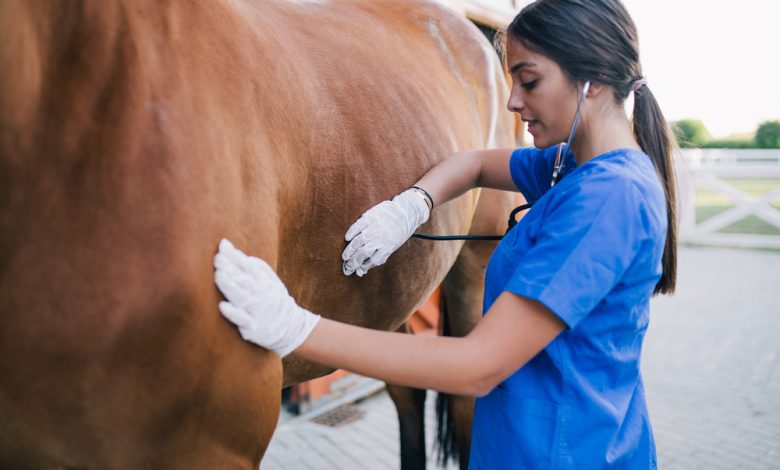
If there’s one thing COVID-19 has taught us, it’s that animals are just as capable of catching the virus as humans. Examples of animal-related coronaviruses can be traced back to several years before the novel coronavirus tearing through the world currently. Examples of equine coronavirus (ECoV) can be traced back to at least 2010.
Table of Contents
What is Equine Coronavirus?
The term “coronavirus” refers to a microscopic strand of RNA (genetic material similar to DNA) which is covered in proteins. These viruses earned their name because of how the RNA appears to be wearing a crown when viewed up close with microscopes. There are many different groups of coronavirus out there. ECoV is considered a separate species of the coronavirus family and falls under the betacoronavirus 1 genus.
Coronavirus is different from bacteria, in that it has to infect a host cell in order to propagate and spread. Bacteria are able to divide by themselves, but a coronavirus has to borrow the resources of a host cell to do so. Examples of coronaviruses throughout history include severe acute respiratory syndrome (SARS), which made headlines in the early 2000s. Bovine coronavirus, known as BCoV, causes respiratory problems and dysentery in cattle.
Horses can develop coronavirus by ingesting the virus from the feces of infected horses. Upon ingestion, the virus travels to the small intestine and attaches to intestinal cells. The virus attaches to these cells using the proteins attached to it. From there, it fuses with the cell and the RNA from the virus takes over the DNA of the cell. The virus will then use the resources of the host cell to replicate and create thousands of disease particles to continue the cycle.
Nicola Pusteria, DVM, PhD, Dipl. ACVIM, has spent years studying this particular pathogen. Equine coronavirus is considered a relatively new disease, with tests developed for the disease back in 2010. The virus affects the enteric system of adult horses, with outbreaks detected across Europe, the United States, and Japan.
Pusteria worked with colleagues to study 472 horses involved with 20 outbreaks between November 2011 and March 2017. They discovered that only 130 of those horses presented clinical signs of disease even though all of them were diagnosed with the disease. He estimated that anywhere between 4% to 83% of horses would appear healthy with no outward indicator that they had developed ECoV.
Horses that develop symptoms respond well to supportive care, typically fluids and non-steroidal anti-inflammatory drugs (NSAIDs) like flunixin meglumine. It’s rare that a horse will die from the disease. Most ECoV-related deaths are caused by complications rather than the initial infection.
One possibly deadly complication caused by the virus is hyperammonemia. The condition causes mild-to-severe neurological conditions because the bowels are producing too much ammonia. This can be caused by changes in bowel bacteria that cause excessive amounts of ammonia to flood the bloodstream and reach the brain.
Equine Coronavirus Risk Factors
The current data shows that 2-6% of horses believed to be infected actually test positive for equine coronavirus. This stat makes it feel like the virus is relatively insignificant, but the number of infections has grown over the past eight years. Researchers believe this is due to an increase in horse owners recognizing the virus and testing for it.
After looking through all of the data, Pusterla noticed that horses from the Midwest that were used as draft horses, were used in farming and ranching, and were used in breeding programs were the most at-risk of developing the virus. Data from ECoV cases in Japan supported the theory that draft horses were more likely to catch the virus.
Why Testing and Diagnosing Equine Coronavirus is so Important
Equine coronavirus doesn’t seem like a huge issue in the grand scheme of things; it affects less than one in ten horses and most infected horses don’t show symptoms. Even the horses that do develop symptoms generally recover by themselves. Why is it so important to diagnose something that seems so benign?
Researchers argue that even though there isn’t a direct cure for ECoV, testing for the disease does help to rule out other problems that could have specific treatments. Testing also helps to understand disease trends and helps farmers and ranchers to put together an effective infection control plan.
Equine coronavirus should be regarded with the same consideration as other viruses, including equine herpes-virus. Both diseases are highly infectious and can quickly spread between horses. Seemingly healthy horses are also able to shed ECoV like they can shed herpes-virus.
Given how many things can cause intestinal inflammation in horses it is worth testing for ECoV. For example, diarrhea in horses can be a sign of serious problems including parasites, inflammatory bowel disease, salmonella, and more. Diarrhea is a serious issue for horses because it causes them to lose precious fluids, nutrients, and electrolytes. It also makes them more susceptible to bacterial infections.
Testing for Equine Coronavirus
Many laboratories across the United States offer testing for equine coronavirus. These labs generally use a quantitative PCR test to test for ECoV. The test allows for researchers to quickly find even small amounts of viral genetic material in feces samples. Veterinarians are in charge of ordering these tests and are responsible for submitting fecal matter for testing. It takes approximately three business days to get back the results.
One problem with testing is that horses could test negative during early stages of infection. It can take three to four days from symptoms appearing for a test to come back positive. Testing can also note make much of a difference in how horses are treated for sporadic cases. Horses should be tested for other, more serious conditions, such as salmonella.
How to Prevent Equine Coronavirus Infection
Much like other horse-related infectious diseases, particularly ones caused by viruses, it’s important to have a proper disease control and containment strategy in place. Strategies include isolating any new horses brought to the property, isolating any sick animals and caring for them after caring for other horses, and using disinfectants and protective equipment to prevent the disease spreading.
Unfortunately, there is currently no vaccine in place for equine coronavirus. Researchers in Japan have recently tested a bovine coronavirus vaccine which could potentially be used to treat ECoV. Using a bovine coronavirus vaccine is similar to treating Lyme disease in horses by using the vaccine used for Lyme disease in dogs.
Researchers noted that the BCoV vaccine helped to produce antibodies for ECoV for young Thoroughbred horses. Each horse was given the vaccine twice with 28 days between doses. The authors of the study noted that blood antibody levels hadn’t increased by a noticeable amount, however.
There was insufficient evidence to suggest that the antibodies provided by the bovine vaccine would be effective against equine coronavirus. Researchers would need to expose healthy horses to the virus after vaccinating them to get a better idea of how efficient the vaccine would be. There must also be studies into how safe it is to apply the bovine vaccine to horses.
Conclusion
Researchers are making great progress towards understanding equine coronavirus. Even so, there are still holes to be filled in when it comes to this virus. One thing researchers must work on in particular is finding ways to prevent infections. So far, the only prevention method is the same method for anything like this; controlling infections after they happen.





Leave a Reply
Thank you for your response.
Please verify that you are not a robot.